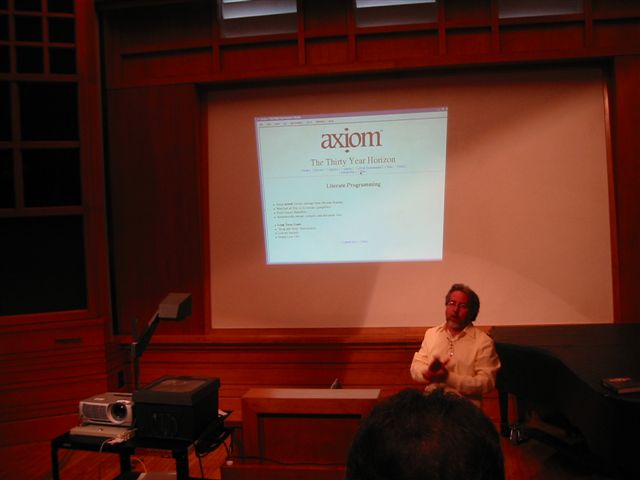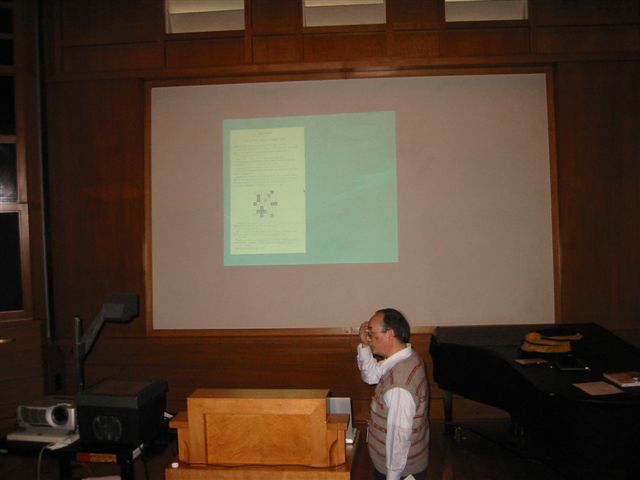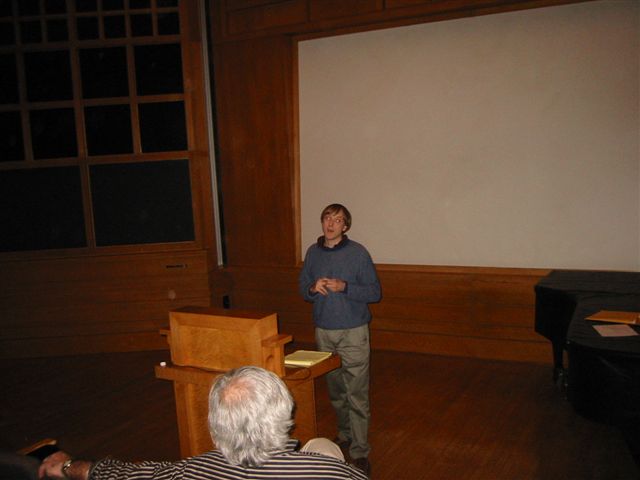|
|
|
last edited 18 years ago |
Edit detail for Axiom meeting 2005 revision 1 of 1
| 1 | ||
|
Editor: 127.0.0.1
Time: 2007/11/10 00:32:44 GMT-8 |
||
| Note: | ||
changed: - See also: [Next Axiom Meeting] _Axiom Conference Announcement_ When: April 22, 2005 Where: The City College of New York Contact: Bernice Ravitz <bernice@rio.sci.ccny.cuny.edu> Url: http://zebra.sci.ccny.cuny.edu/web/caiss/AxiomConference.html There will be a Conference on Axiom on April 22, 2005 at the City College of New York. The focus of the conference will be to demonstrate the power and scope of Axiom to a general scientific audience. The conference is being hosted by CAISS, the Center for Algorithmic and Interactive Scientific Software. Timothy Daly, a senior research scientist at CAISS and a Research Associate in the Computer Science Department of CCNY has been heavily involved in the development of AXIOM over many years. Axiom, developed by IBM and released as open source software by NAG, has now been rebuilt by many developers into its original form together with a new version for Windows. Preceding the conference, on April 21st, will be a "sprint" day devoted to defining future directions and a marathon programming session in the CAISS Open Software Lab. Everyone is encouraged to participate. Help will be available for new developers. The Acting Dean of Engineering, Joe Barba and the Dean of Science, Maria Tamargo, are sponsoring the conference, which is also supported by the National Science Foundation. Further funding has been made available by the Chancellor of the City University of New York, Dr. Matthew Goldstein and the Provost of the City College of New York, Zeev Dagan, for both travel and accommodation for some participants and attendees of one or other or both events. Details of the talks on April 22nd and the get-together on April 21st will be posted on the CAISS web-site, www.caissny.org in the next few weeks. Anyone interested in attending should email Bernice Ravitz <bernice@rio.sci.ccny.cuny.edu>. The conference is being organized by Gilbert Baumslag, Timothy Daly, Gretchen Ostheimer, William Sit and Douglas Troeger. *On Fri, 21 Jan 2005 11:15:14 -0500 Gilbert Baumslag* From Page,Bill Tue Apr 26 11:58:38 -0500 2005 From: Page, Bill Date: Tue, 26 Apr 2005 11:58:38 -0500 Subject: RE: [Axiom-developer] conference Message-ID: <68207C39878CC54695B4E7A1D58E098101B304CB@CORPORATEEX> On Tuesday, April 26, 2005 10:37 AM Martin Rubey wrote: >Camm Maguire writes: > > Hi Tim! Great conference! > > So, what happened? I attended both the pre-conference (sprint) day and the main conference. The two days seemed to go by very quickly which for me usually means that it was interesting, worthwhile, but that there was too much to do in too little time. While it is still fresh in my mind I will try to list below some of the things that stood out for me and I hope other participants will add their comments as well. I will let Tim report on the actual statistics, but I think the conference was quite well attended, considering that it was the first ever meeting about the new open source version of Axiom. We had about 7 or 8 people the first day and somewhere between 30-50 people the second day. The City College campus was a great venue. The apple and cherry blossoms highlighted the wonderfully maintained historical buildings which seemed to me to blend well with those of more modern architecture and the distant backdrop of New York city skyscrapers ... (there that is the extent of my capacity for poetic imagery :). Plus I would like to say thank you to Gilbert Baumslag and Bernice Ravitz for their generous hospitality. The discussion on the sprint day was lead by Tim Daly and revolved around future directions and the larger, longer term context in which open source Axiom will develop. For those people who have been following the discussion here on the Axiom-developer list for the last two years, much of what we discussed would have seemed familiar. We talked about many things, but here as some that come immediately to mind: - literate programming and documentation, pamphlet format files (noweb) and implementation on the web - mathematical versus program correctness and relationship to proof systems like ACL2, - user interfaces, both desktop and web-based; and their integration (the doyen project) I am sure we can add other things to this list. It did seem to me however that (as usual and normal in an open source project) we did not really make any firm decisions. We have many more ideas for projects and research than there are available resources. During the latter part of the day we spent some time on more technical issues such as the role of GCL in support of platform independent graphics (for both Linux/Unix and Windows). Tim demonstrated a possible Java-based solution but I think the idea of adding a Java dependency to Axiom motivated all of us to think of ways that this could be achieved more directly with GCL and tcl/tk. I also helped set up a Windows development environment for Axiom on one of the workstations in the open source development lab. Tim and I worked (without a complete resolution) on a problem of building the new Axiom book volumes from the tla archives in the Windows environment. There seems to be an issue with noweb even though it works properly for building Axiom from source on Windows. The main conference day was to be devoted to applications of Axiom. Perhaps there was not enough discussion of actually applications, however William Sit did give some examples of the using Axiom "for both fun and research" and during part of my talk (which was mainly about the MathAction website and how it supports both Axiom development and Axiom users) I did point out the work on "guessing integer sequences" that Martin Rubey has posted on www.axiom-developer.org Tim Daly opened the conference with an overview of Axiom and the concept of the "30 Horizon": 30 years back from a historical perspective and 30 years forward. He gave reasons why we might believe that Axiom will still be actively used and developed 30 years from now and what we might be able to do now to help ensure this. Richard Fateman discussed the "state-of-the-art" in what one might call the "artificial intelligence view" of computer algebra systems, he pointed out that although current systems like Axiom, Maxima and commercial systems like Mathematica and Maple are useful for symbolic computation, they are still a long way from being "artificial mathematicians". I think also that with his analogy of a "mathematical golem", Richard might have also been trying to suggest that the goal of creating artificial mathematicians might not be such a good idea. :) Camm Maquire gave a talk on the history and potential of open source software. To me this was a bit of a surprise given Camm's specific and detailed technical contributions to both GCL and Axiom, but at a conference focused on **applications** I think these are issues that need to be addressed. How can we convince academic and commercial budget managers that open source can compete effectively with commercial products when the economics and motivations are so different? In all of the talks there seemed to be a common thread of the need for collaboration - between Axiom developers; among Axiom users and between mathematicians and the Axiom system. I think there was a general agreement that in the open source Axiom project so far we have achieved some significant steps in the right direction but that there remains a lot more to do. Finally, I want to add a special personal thanks to Richard Fateman for solving a last minute technical problem with network access to the axiom-developer.org website by the loan of his laptop computer and wireless Internet connection. Without his help I don't think I could have given a particularly convincing verbal demonstration of the potential for the MathAction website to support the kinds of collaboration that Axiom needs. Bill Page. Photos Here are few selected pictures from the conference. Venue <img src="AxiomMeeting2005-09.jpg" /> William Sit (left) with Gilbert Baumslag (right) <img src="AxiomMeeting2005-04.jpg" /> Tim Daly <img src="AxiomMeeting2005-05.jpg" /> William Sit <img src="AxiomMeeting2005-07.jpg" /> Richard Fateman <img src="AxiomMeeting2005-08.jpg" /> Camm Maguire <img src="AxiomMeeting2005-10.jpg" />
See also: [Next Axiom Meeting]?
Axiom Conference Announcement
When: April 22, 2005
Where: The City College of New York
Contact: Bernice Ravitz
Url: http://zebra.sci.ccny.cuny.edu/web/caiss/AxiomConference.html
There will be a Conference on Axiom on April 22, 2005 at the City College of New York. The focus of the conference will be to demonstrate the power and scope of Axiom to a general scientific audience. The conference is being hosted by CAISS, the Center for Algorithmic and Interactive Scientific Software. Timothy Daly, a senior research scientist at CAISS and a Research Associate in the Computer Science Department of CCNY has been heavily involved in the development of AXIOM over many years.
Axiom, developed by IBM and released as open source software by NAG, has now been rebuilt by many developers into its original form together with a new version for Windows. Preceding the conference, on April 21st, will be a "sprint" day devoted to defining future directions and a marathon programming session in the CAISS Open Software Lab. Everyone is encouraged to participate. Help will be available for new developers.
The Acting Dean of Engineering, Joe Barba and the Dean of Science, Maria Tamargo, are sponsoring the conference, which is also supported by the National Science Foundation. Further funding has been made available by the Chancellor of the City University of New York, Dr. Matthew Goldstein and the Provost of the City College of New York, Zeev Dagan, for both travel and accommodation for some participants and attendees of one or other or both events.
Details of the talks on April 22nd and the get-together on April 21st will be posted on the CAISS web-site, www.caissny.org in the next few weeks.
Anyone interested in attending should email
Bernice Ravitz
The conference is being organized by Gilbert Baumslag, Timothy Daly, Gretchen Ostheimer, William Sit and Douglas Troeger.
On Fri, 21 Jan 2005 11:15:14 -0500 Gilbert Baumslag
Camm Maguire writes:Hi Tim! Great conference!So, what happened?
I attended both the pre-conference (sprint) day and the main conference. The two days seemed to go by very quickly which for me usually means that it was interesting, worthwhile, but that there was too much to do in too little time. While it is still fresh in my mind I will try to list below some of the things that stood out for me and I hope other participants will add their comments as well.
I will let Tim report on the actual statistics, but I think the conference was quite well attended, considering that it was the first ever meeting about the new open source version of Axiom. We had about 7 or 8 people the first day and somewhere between 30-50 people the second day.
The City College campus was a great venue. The apple and cherry blossoms highlighted the wonderfully maintained historical buildings which seemed to me to blend well with those of more modern architecture and the distant backdrop of New York city skyscrapers ... (there that is the extent of my capacity for poetic imagery :). Plus I would like to say thank you to Gilbert Baumslag and Bernice Ravitz for their generous hospitality.
The discussion on the sprint day was lead by Tim Daly and revolved around future directions and the larger, longer term context in which open source Axiom will develop. For those people who have been following the discussion here on the Axiom-developer list for the last two years, much of what we discussed would have seemed familiar. We talked about many things, but here as some that come immediately to mind:
- literate programming and documentation, pamphlet format files (noweb) and implementation on the web
- mathematical versus program correctness and relationship to proof systems like ACL2,
- user interfaces, both desktop and web-based; and their integration (the doyen project)
I am sure we can add other things to this list. It did seem to me however that (as usual and normal in an open source project) we did not really make any firm decisions. We have many more ideas for projects and research than there are available resources.
During the latter part of the day we spent some time on more technical issues such as the role of GCL in support of platform independent graphics (for both Linux/Unix and Windows). Tim demonstrated a possible Java-based solution but I think the idea of adding a Java dependency to Axiom motivated all of us to think of ways that this could be achieved more directly with GCL and tcl/tk.
I also helped set up a Windows development environment for Axiom on one of the workstations in the open source development lab. Tim and I worked (without a complete resolution) on a problem of building the new Axiom book volumes from the tla archives in the Windows environment. There seems to be an issue with noweb even though it works properly for building Axiom from source on Windows.
The main conference day was to be devoted to applications of Axiom. Perhaps there was not enough discussion of actually applications, however William Sit did give some examples of the using Axiom "for both fun and research" and during part of my talk (which was mainly about the MathAction website and how it supports both Axiom development and Axiom users) I did point out the work on "guessing integer sequences" that Martin Rubey has posted on www.axiom-developer.org
Tim Daly opened the conference with an overview of Axiom and the concept of the "30 Horizon": 30 years back from a historical perspective and 30 years forward. He gave reasons why we might believe that Axiom will still be actively used and developed 30 years from now and what we might be able to do now to help ensure this.
Richard Fateman discussed the "state-of-the-art" in what one might call the "artificial intelligence view" of computer algebra systems, he pointed out that although current systems like Axiom, Maxima and commercial systems like Mathematica and Maple are useful for symbolic computation, they are still a long way from being "artificial mathematicians". I think also that with his analogy of a "mathematical golem", Richard might have also been trying to suggest that the goal of creating artificial mathematicians might not be such a good idea. :)
Camm Maquire gave a talk on the history and potential of open source software. To me this was a bit of a surprise given Camm's specific and detailed technical contributions to both GCL and Axiom, but at a conference focused on applications I think these are issues that need to be addressed. How can we convince academic and commercial budget managers that open source can compete effectively with commercial products when the economics and motivations are so different?
In all of the talks there seemed to be a common thread of the need for collaboration - between Axiom developers; among Axiom users and between mathematicians and the Axiom system. I think there was a general agreement that in the open source Axiom project so far we have achieved some significant steps in the right direction but that there remains a lot more to do.
Finally, I want to add a special personal thanks to Richard Fateman for solving a last minute technical problem with network access to the axiom-developer.org website by the loan of his laptop computer and wireless Internet connection. Without his help I don't think I could have given a particularly convincing verbal demonstration of the potential for the MathAction website to support the kinds of collaboration that Axiom needs.
Bill Page.
Photos
Here are few selected pictures from the conference.
Venue

William Sit (left) with Gilbert Baumslag (right)

Tim Daly

William Sit

Richard Fateman

Camm Maguire
